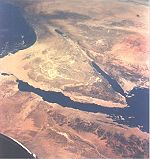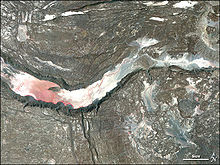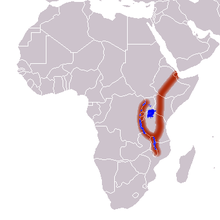
Great Rift Valley (geographical concept)
Background Information
SOS Children has tried to make Wikipedia content more accessible by this schools selection. SOS Children is the world's largest charity giving orphaned and abandoned children the chance of family life.
| Kenya Lake System in the Great Rift Valley | |
|---|---|
| Name as inscribed on the World Heritage List | |
 Lake Nakuru in the Kenya Lake System
|
|
| Country | Kenya |
| Type | Natural |
| Criteria | vii, ix, x |
| Reference | 1060 |
| UNESCO region | Africa |
| Coordinates | 0.1°S 36.1°E Coordinates: 0.1°S 36.1°E |
| Inscription history | |
| Inscription | 2011 (444 Session) |
The Great Rift Valley is a name given in the late 19th century by British explorer John Walter Gregory to the continuous geographic trench, approximately 6,000 kilometres (3,700 mi) in length, that runs from northern Syria to central Mozambique in South East Africa. The name continues in some usages, although it is today considered geologically imprecise as it combines features that are today regarded as separate, although related, rift and fault systems. Today, the term is most often used to refer to the valley of the East African Rift, the divergent plate boundary which extends from the Afar Triple Junction southward across eastern Africa, and is in the process of splitting the African Plate into two new separate plates. Geologists generally refer to these incipient plates as the Nubian Plate and the Somali Plate.
Theoretical extent

The Great Rift Valley as originally described was thought to extend from Lebanon in the north to Mozambique in the south, and constitutes one of two distinct physiographic provinces of the East African mountains. It included the Jordan Rift Valley, Red Sea Rift and the East African Rift. Today these rifts and faults are seen as distinct, although connected.
Sinai peninsula

The northernmost part of the Rift, today called the Dead Sea Transform or Rift, forms the Beqaa Valley in Lebanon separating the Lebanon Mountains and Anti-Lebanon Mountains. Further south it is known as the Hula Valley separating the Galilee mountains and the Golan Heights. The River Jordan begins here and flows southward through Lake Hula into the Sea of Galilee in Israel, then continues south through the Jordan Rift Valley into the Dead Sea on the Israeli-Jordanian border. From the Dead Sea southwards, the Rift is occupied by the Wadi Arabah, then the Gulf of Aqaba, and then the Red Sea. Off the southern tip of Sinai in the Red Sea, the Dead Sea Transform meets the Red Sea Rift which runs the length of the Red Sea. The Red Sea Rift comes ashore to meet the East African Rift and the Aden Ridge in the Afar Depression of East Africa. The junction of these three rifts is called the Afar Triple Junction.
Africa

The East African rift has two branches, the Western Rift Valley and the Eastern Rift Valley.
The Western Rift, also called the Albertine Rift, is edged by some of the highest mountains in Africa, including the Virunga Mountains, Mitumba Mountains, and Ruwenzori Range. It contains the Rift Valley lakes, which include some of the deepest lakes in the world (up to 1,470 metres(4,800 ft) deep at Lake Tanganyika). Much of this area lies within the boundaries of national parks such as Virunga National Park in the Democratic Republic of Congo, Rwenzori National Park and Queen Elizabeth National Park in Uganda, and Volcanoes National Park in Rwanda. Lake Victoria is considered to be part of the rift valley system although it actually lies between the two branches. All of the African Great Lakes were formed as the result of the rift, and most lie within its rift valley.
In Kenya, the valley is deepest to the north of Nairobi. As the lakes in the Eastern Rift have no outlet to the sea and tend to be shallow, they have a high mineral content as the evaporation of water leaves the salts behind. For example, Lake Magadi has high concentrations of soda ( sodium carbonate) and Lake Elmenteita, Lake Bogoria, and Lake Nakuru are all strongly alkaline, while the freshwater springs supplying Lake Naivasha are essential to support its current biological variety.




